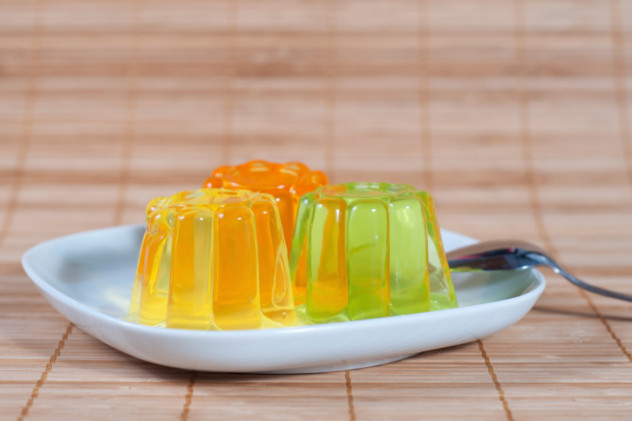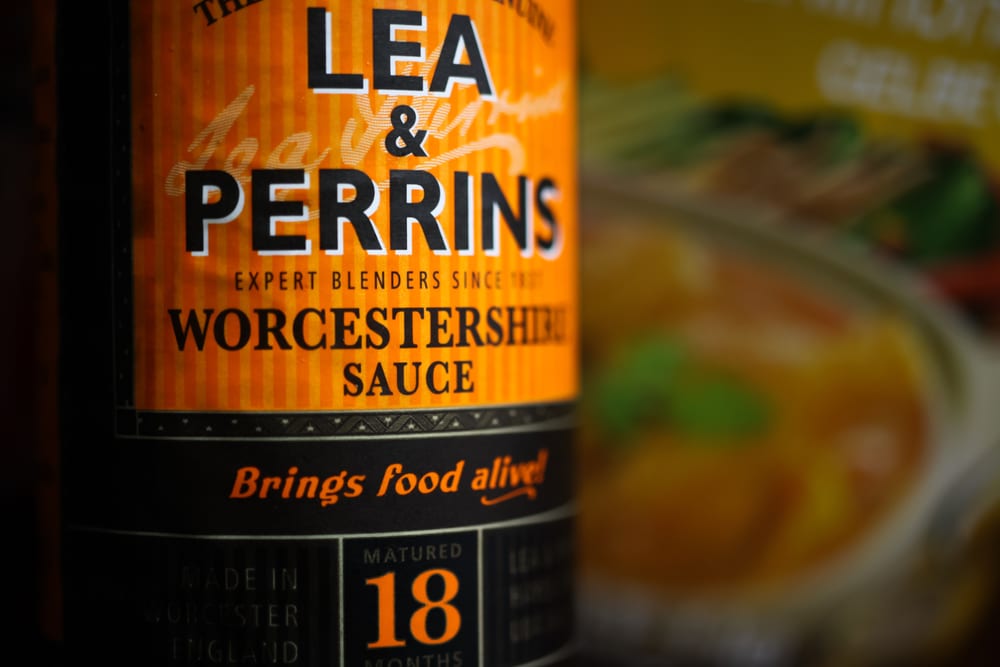Most of us have been subject to a condescending lecture on the excesses of the food industrial complex. And most of the time our internal monologue tells our obnoxious comrade to choke on his kale and quinoa salad. But sometimes they have a point. Last week we tackled animal-related atrocities in a variety of sectors, including clothing (fur farms), fragrances (beaver castor sac harvesting) and houseware (bone china). This list deals more closely, though not exclusively, with food and drink. Spoiler alert: you’re eating bugs, bones and hair. Top 10 Reasons To Reject Vegetarianism
10 Jell-O
It’s sweet! It’s jiggly! It’s semi-translucent! People have been consuming some form of what has become the world’s most popular pre-made dessert since the mid-17th Century. In fact, traces of gelatin found in a pharaoh’s grave suggest it likely was concocted and consumed in ancient Egypt. Jell-O is a broadly genericized brand name – it is to gelatin what Kleenex is to tissues. The word “gelatin” comes from the Latin “gelatus,” which means “frozen jelly.” Far from the easy diner-esque dessert it is today, gelatin was once considered a sign of wealth. This is because, before the advent of prepared gelatin, only members of the elite classes could afford the kitchen help needed to render, clarify, and prepare it as part of ornate salads and sweets. But while gelatin was once fancy, it was never vegetarian-friendly. The first reference to it in Western civilization dates to 1682. Documenting a demonstration of the first pressure cooker, Englishman John Evelyn described the creation of a “jellye made of bones of beef.” Yum! Centuries later, Jell-O is still derived from animal bones and skin. Specifically, it’s made from decaying animal hides, boiled crushed bones, and the connective tissues of cattle and pigs. However, vegetarian gelatin desserts made from plant-based gums or seaweeds like agar or carrageenan are widely available.
9 Capsules
Have a headache? If you’re vegetarian or vegan, choose your remedy wisely. The same animal skin, bone, and tissue-derived main ingredient as Jell-O – gelatin – is also widely used to create capsules for both over-the-counter and prescription pharmaceuticals. The main reason is gelatin’s structural versatility and natural compatibility; in layman’s terms, gelatin-based capsules are easily sculpted, compatible (meaning no adverse reactions) with a wide array of pharma product ingredients, and durable enough to prevent moisture incursions during the product’s stated shelf life. So basically, gelatin capsules can withstand the myriad stressors demanded of an oral dosage delivery system. Notably, gelatin capsules create a cultural conflict for groups who steer clear of ingesting animal products. For example, some religions prominent in India require vegetarianism, leading to long-running pharmacological debate in the country’s prolific pharma production industry. This issue was a key factor in the development of starch-based vegan-friendly alternatives called HPMC capsules, which perform similarly to their gelatin-based counterparts throughout the rigors of initial formulation, product filling and differing supply chain environments. Animal parts can frequently be found in other pharmaceuticals products as well, typically as inactive (meaning non-curative) ingredients like binders, fillers and colorants. Animal-derived ingredients may also be used to stabilize vaccine formulations, a fact not missed by vaccination pro-choicers.
8 Sugar
Got a sweet tooth? Then you might be eating… well, teeth, among other bones. Bone char is a porous, black, granular material produced by (duh) charring animal bones, typically cattle. It consists mainly of tricalcium phosphate, calcium carbonate and carbon, and is primarily used for filtrating and decolorizing a variety of sugars. The bones are sold to traders who then sell them to the U.S. sugar industry. Bone char is used in many types of sugar including brown sugar and confectioner’s sugar, and is openly used by prominent US manufacturers and suppliers – including the country’s highest profile brand, Domino’s (no relation to the pizza chain). Like white sugar? Then more bone char for you! As efficient as it can be in filtering out certain impurities, bone char is an inefficient discolorant, so the whiter the sugar, the likelier high volumes of bone char were employed. Not in the US? Then unfortunately you’re probably missing out on the wholesome, all-natural bone charry goodness. The UK, EU, Australia and other developed countries have largely phased out bone char in sugar production, proving once again what a truly exceptional nation America is. Anyway, how bonecharry do you take your coffee? One lump or two?
7 Cigarettes
Wanna smoke some beaver taint? All the cool kids are doing it. A wide variety of pre-rolled cigarettes contain castoreum, harvested from the territory-marking castor sacs of beavers. To procure this product, beavers are euthanized, and their paste-filled castor sacs smoked or sun-dried until they resemble dried figs. Why add something from a beaver’s ass to a cigarette, you ask? Why, for the taste! Castoreum – which is also used in fragrances to evoke leathery notes – provides a sweetness or a seemingly redundant “enhanced smokiness” to cancer sticks. Count the cowboyest of cowboys – the Marlboro Man – in on smoking beaver sac paste: prominent cigarette manufacturer Philip Morris, maker of Marlboro brands, is known to have flavored some 400 billion smokes with castoreum in one year alone. Cigarettes: first they kill beavers, then they kill you. Bonus: Another specialty product that uses castoreum – and openly, rather than clandestinely calling it a “natural flavor” – is a Swedish drink called bäversnaps. That’s right, it’s beaver musk-flavored schnapps. To produce it, castoreum is soaked in high-proof alcohol, which takes on the flavor over time.
6 Beer and Wine
Have a drinking problem? Well, you might after reading this. Isinglass is a gelatin-like substance collected from the dried bladders of freshwater fish, such as sturgeon. A type of collagen, it is frequently used in the fining or clarification of various beers and wines. For a better idea of the type of substance we’re dealing with here, the same gunk also can be cooked into a paste for gluing applications. Finings are substances added to beer, wines or certain non-alcoholic juice beverages, at or near the completion of the brewing process. Isinglass is especially valuable for producing cask-conditioned beers, meaning its use is particularly prolific in the UK. Meanwhile, clarification is a term more narrowly associated with winemaking. It refers to the process of removing insoluble items – including dead yeast cells, bacteria, tartrates, proteins, tannins, and pieces of grape skin, pulp or stems – prior to bottling. In both cases, isinglass accelerates the settling process, meaning it shortens the time in which unwanted insolubles can be removed. It basically makes the production process go faster in an environment where time is often money. For those who don’t wish to literally drink fish while drinking like a fish, guides listing vegan beers and wines are readily available.
5 Red Candy, Gum, Jams, Syrups…
… and pretty much anything you eat that is unnaturally tinted pink or red. What animal product are you consuming when enjoying a cherry Italian ice, strawberry hard candy or cinnamon-flavored gum? Relax, it’s just… bugs. Specifically, such consumables contain red cochineal beetles – which, when dried and crushed, produce a powder called carmine. In food applications, carmine is widely known as a highly effective colorant. Cherry-flavored syrups, raspberry jams, and any number of red-tinted beverages all frequently use carmine, as do a wide range of dairy products. For years, carmine brought an added benefit to food manufacturers: since it’s basically pulverized insect, it can legitimately be called “all natural.” All ingredient ambiguities aside, many regulatory bodies, including the US Food & Drug Administration, now mandate carmine be explicitly listed on labels. However, if you think you can avoid ingesting insects simply by steering clear of reddish foods, think again. If you’ve had any sort of hard or shiny candy, you’ve likely had a hearty helping of a bug excretion called shellac. A resin secreted by the female lac bug on trees in the forests of southern Asia, the gunk is gathered, processed and sold as dry flakes, then dissolved in alcohol to make confectioner’s glaze. Most hard or shiny candies are coated with the stuff, with a notable exception being M&Ms.
4 Worcestershire Sauce
Wait… something’s fishy here. A versatile marinade or condiment for everything from steaks to shellfish to shepherd’s pie, Worcestershire sauce has been complementing meals for nearly two centuries. More complicated than most of its culinary counterparts, it was invented in the 1830s by two chemists in (you guessed it) Worcester, England. In fact, perhaps the most prominent brand – Lea & Perrins, named for its inventors – is still manufactured there today. To produce its unique flavor profile – which combines tangy, savory, sweet and salty – a heck of a lot goes into making Worcestershire sauce. The fermented concoction comprises a vinegar base flavored with a combination of sweeteners and seasonings, which may include molasses or sugar, tamarind, onion, garlic, chili pepper extract, soy, salt, cloves, lemon essence, pickle juice, and… … anchovies? That’s right: The same ingredient most of us refuse to eat on pizza is what gives Worcestershire sauce its “umami,” which officially joined salty, sweet, bitter and sour as the “fifth taste” in 1990. Umami loosely means “essence of deliciousness” in Japanese, and its taste is often described as the meaty, savory helper that deepens supplementary flavors. For Worcestershire sauce, anchovies are fermented in vinegar for about 18 months.
3 Condoms
Add “but baby, I’m vegan” to the lengthy list of lines designed to convince a sex partner to forgo contraception. While the primary ingredient in most condoms is latex, which is plant-based, most cock socks also contain casein and glycerin. For most, the lesser of the two offenders is casein. Derived from a milk protein, casein is used to help make rubber condoms smooth and thin. It’s typically added while the latex is still in liquid form, so the solid materials become both sleeker and more flexible. Casein also gives most latex love gloves their trademark sour odor. Hot! But while casein is animal-derived, glycerin often is animal, period. Used in a wide variety of products, glycerin can also be derived from vegetable oils, but in most pecker protectors the animal version is utilized to provide abundant lubrication. Fortunately for vegan vaginas, semen shields that are 100% certified animal product-free are available. Other common, albeit less sexy, products that contain glycerin include toothpastes, moisturizers, shampoos & conditioners, detergents, shaving creams and a variety of cosmetics. More often than not, whether the glycerin is animal or plant-based is not divulged.
2 Crayons
Recently my preschool-age son drew his daddy a picture of the whole family on a beach. It had a Lemon Yellow sun, Burnt Orange sand, a Carpenter Pink dada and, of course, a Sky Blue sky and Sea Green ocean. You might recognize these as popular colors of… … waxy beef fat sticks? You guessed it: crayons contain animal products. In fact, the nostalgic scent strongly associated with the freewheeling fun of coloring is actually the stench of stearic acid – processed beef fat. Stearic acid is used as a coagulation chemical, which means it helps crayons solidify properly and remain consistent throughout their paper-peeling lifespan. Stearic acid also is commonly used in another waxy household staple: candles. And while stearic acid also can be derived from certain plant-based items, including coconuts, that process is more labor intensive and therefore less cost-effective. For that reason, animal rights organizations recommend consumers assume the stearic acid in their candles is animal-derived unless expressly indicated otherwise. On the bright side, candles are about the only way many of us actually do anything that burns fat.
1 Bagels
This is the world we live in: a prominent restaurant chain called Panera Bread Company, which has more than 2,000 locations in the US and Canada, proudly proclaims on its website that its bagels aren’t made with bird feathers and HUMAN HAIR. Many processed bagels and bread products contain an enzyme called L. Cysteine, a “dough conditioner” derived from all-natural, all-disgusting sources: poultry feathers and both hog and human hair. While it’s possible to make synthetic L. Cysteine, it’s an expensive process. So rather than making fake hair and imitation feather (or sticking to flour, water, salt and yeast like reasonable people), the cost-effective choice involves us eating hair. Take a bow, capitalism! Several major US-based chains, including Dunkin’ Donuts and Einstein Bros., have confirmed using L. Cysteine in all of their bagels. Hair and feathers also make an appearance in the garlic bread at Pizza Hut and in McDonald’s honey wheat rolls, cinnamon rolls, and apple pies (warm hair—yum!). Fortunately for food shoppers, the most prominent grocery store bagel brand, Lenders, is free of L. Cysteine. However, the same cannot be said about many large-scale bread brands, so the best bet for avoiding the hair and feather treatment is patronizing a local baker. It would be remiss of us to leave this list without a little animal/vegetable humour: How can you tell if someone’s a vegan? Answer: They’ll tell you! Top 10 Things Cancel Culture Has (surprisingly) Not Canceled Yet Read More: Twitter Website























